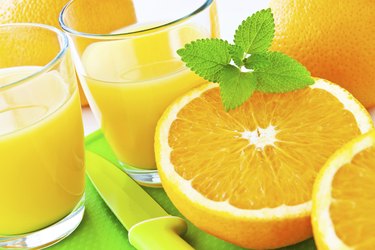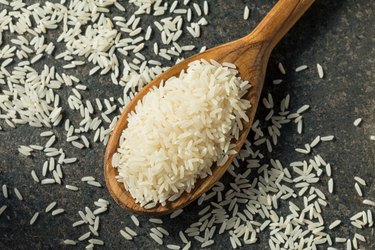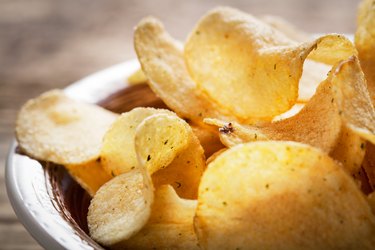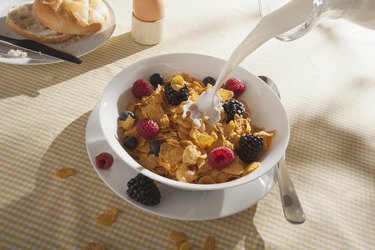
It seems like it should be simple: Eat food and you'll feel full. But not all foods are satisfying — some leave us as hungry as we were before we ate and more likely to over-consume. If you're watching your calories and eager to keep your appetite under control, you'll need to be mindful of the quality of calories — not just the quantity.
"The worst foods for appetite control are simple carbohydrates," says Claudia Hleap RD, LDN. "These foods tend to be broken down in the body very quickly and do not tend to keep you feeling full for long, making the likelihood of overconsumption much higher."
Video of the Day
Video of the Day
It's also important to be wary of manufacturer's marketing.
"Many food manufacturers play to our natural craving by overprocessing foods with copious amounts of fat and sugar," says registered dietitian Mindy Haar, PhD, clinical associate professor and chair of interdisciplinary health sciences at New York Institute of Technology. "Instead of products that are satisfying and filling, they are instead almost irresistible, making it difficult to stop after a moderate amount is consumed, playing havoc on appetite control."
Here, some of the worst foods and beverages for keeping your appetite under control — and what to eat (or drink) in their place.
1. Fruit Juice

If you normally begin your morning with a glass of fruit juice, you may be starting your day — and your appetite — off on the wrong foot.
Whether you buy juice bottled from the store or squeeze it yourself, fruit juice has a twofold problem: missing fiber and a whole lot of sugar, says Jessica Cording, RD, CDN, author of The Little Book of Game Changers: 50 Healthy Habits for Managing Stress & Anxiety.
"While juice often takes on a health halo because of its vitamin content, the lack of fiber and high sugar content in most fruit juice can cause a spike and then crash in blood sugar and lead to poor appetite control," Cording explains.
Both aspects are key: A cup of fruit juice like orange juice contains almost 21 grams of sugar, according to the USDA — that's a serious sugar punch! In fact, it's almost the same as a cup of cola which has 24 grams of sugar, per the USDA. Plus the missing fiber from eating the skin, pulp and "meat" of the fruit means that sugar gets to run wild in your body, unregulated by the fiber that a piece of fruit offers.
What to Have Instead
As an alternative, consider an all-vegetable juice or a smoothie with greens and a small amount of a high-fiber fruit like berries, suggests Cording. Or, you know, just eat the orange.
2. Fat-Free Yogurt
In order for foods to be "fat free" manufacturers often need to make sneaky swaps.
"Fat-free foods do the opposite of what many people believe. Fat-free takes out the fat of foods but the fat is then replaced by other fillers that do not satisfy us and usually leave us wanting more," says Shana Minei Spence, RDN, CDN.
Despite the decrease in the availability of many fat-free snack foods, fat-free yogurt is still a common supermarket staple — one you should skip if you're looking to limit your sugar intake and keep your appetite under control. That's especially true for flavored yogurt varieties — a 6-ounce container of one brand of nonfat flavored yogurt contains 21 grams of sugar, per the USDA.
What to Eat Instead
To get the probiotic benefits of yogurt, skip the fat-free varieties and instead opt for protein-packed plain full-fat, Greek-style yogurt. Then, add DIY toppings such as fruit, nuts and seeds.
3. White Rice

Although white rice often likes to hitch a ride on the plate with healthier foods like a salmon filet or stir-fried veggies, white rice itself has little nutritional value, according to the University of Pittsburgh Medical Center. In order to create white rice, the bran and germ, rice's most nutritious parts, are milled away. (This is why brown rice is healthier than white rice.)
"White rice is packed full of refined carbohydrates that digest quickly in the body with little fiber to slow the digestive process," explains Erin Palinski-Wade, RD, CDE, a New Jersey-based dietician and author of Belly Fat Diet for Dummies. "Because white rice digests so quickly, it spikes blood sugar levels which in turn spike insulin levels, driving appetite and cravings."
In fact, you may find that you feel hungrier after eating white rice, Palinski-Wade says.
What to Eat Instead
Next time you need a side for your stir fry, try riced cauliflower, suggests Palinksi-Wade. “Packed full of fiber and antioxidants with few calories, riced cauliflower can absorb the flavor of any seasoning you add and make a nutritious, filling alternative to white rice.”
4. Granola Bars
While granola bars are often made with seemingly healthy ingredients like oats, nuts, seeds and dried fruit, many "traditional granola bars can be chocked full of sugar, simple carbs and artificial flavors," says Dawn Younts, FNTP, CNC, a certified nutritional consultant and functional nutritional therapy practitioner.
And, they're likely to leave you hungry compared to other snacks. Having a low-sugar snack such as hummus and pretzels compared to a granola bar led to a decrease in overall signs of hunger, as well as a 20 percent reduction in subsequent snacking on desserts, according to an August 2020 study published in the Journal of Nutrition.
What to Eat Instead
While the convenience of a granola bar is hard to beat, aim for a healthier option by choosing a bar that includes more whole foods like nuts, seeds and dried fruits and limited added sugar, says Younts.
Or, try your hand at homemade granola bars that let you completely control added sugar, fat and salt.
5. Diet Soda
Regular soda packs a serious sugar punch and fills you up with empty calories, but switching to diet soda doesn't do your body any favors either. While diet soda may offer a cut in calories, people who switched to diet soda were more likely to eat a higher number of calories than those who drank regular soda, according to a March 2014 study in the American Journal of Public Health.
In addition to consuming more calories overall, those added calories are more likely to come from high-fat, high-sugar foods, says Jenna Appel, RD, LDN, a certified diabetes care and education specialist.
"Research shows that diet soda drinkers can have higher activity in the area of the brain associated with the desire to consume foods high in sugar and fat, which could in turn change how the brain reacts to cravings for high-calorie foods," Appel says. This may occur due to the ability of the artificial sweetener found in diet soda to decrease the brain's reward processing of sweet taste leading to over-consumption, per a November 2012 study in Physiology & Behavior.
What to Drink Instead
While H2O is king when it comes to hydration, a big cup of water can seem like a sad substitute for a diet soda habit. Luckily, according to a January 2016 study in the American Journal of Clinical Nutrition, you can retrain your taste buds to enjoy something less sweet. Give your taste buds a few weeks to adjust by trying seltzer or mineral water flavored only with real fruit juice, such as a spritz of lemon or lime.
6. Chain-Store Smoothies
If you've skipped the lunchtime pizza slice and are instead opting for a smoothie with fruits and vegetables, it seems like you should be getting a good nutritional bang for your smoothie buck. But unlike a smoothie you might make at home, chain-store smoothies are often made with fruit juice, frozen yogurt or even sherbet added into the blender.
"Smoothies that are made with frozen yogurt, juice, and fruit tend to be much higher in sugar," Younts says. "This stimulates the body to want even more sugar."
A large size of a fruit smoothie made with dairy and whole fruits and vegetables could have as much as 89 grams of sugar, per the USDA.
What to Drink Instead
If you're selecting a smoothie from a chain store, be sure to aim for a healthier balance by choosing one with limited juice or sherbet. Then, make sure it has whole fruits or veggies blended in and protein to balance the sugar.
Cording suggests adding protein via Greek yogurt, kefir, protein powder or your favorite nut or seed butter. You can also opt to make your own smoothie at home with added spinach or kale for fiber and coconut water instead of juice.
7. Chips

Salty, crunchy and oh-so-tasty — an open bag of chips can be hard to resist. And it's not all in your head. An April 2014 study in the Journal of Nutrition that found that salt increases "passive consumption" which is why you can mindlessly eat your way through a whole bag of chips without realizing it.
And it's not just the saltiness of chips that makes it hard to stop with just one handful — even the sound of crunching chips makes us want more. The more prominent a food sounds when you eat it, the more you'll consume since the auditory experience increases how good you think it tastes, according to a July 2019 study in the journal Appetite.
So if you are craving a snack that fills you up, you may want to rethink that afternoon chip choice, Palinski-Wade says. "With refined carbs, lots of sodium and little nutrients to fill you up like fiber, chances are you will be just as hungry after eating."
What to Eat Instead
If you’re craving a salty snack, try a bowl of air-popped popcorn instead. Three cups of this crunchy snack has 90 calories and more than three gams of fiber, per the USDA.
It's a "high-volume snack that will leave you feeling satisfied,” Palinski-Wade says. In fact, you'll feel even more satisfied than the same amount of chips, according to a September 2013 study in the journal Nutrition.
If your heart’s set on having chips, keep your appetite in check by using portion control. Divvy out one serving in a bowl and then put the bag away to avoid the temptation to refill the bowl.
8. Breakfast Cereal

That big bowl of flakes may not be the best way to fuel your day.
"A bowl of cereal may seem like a quick breakfast option, but when it is packed full of refined flour and added sugars, it will drive your appetite versus control it," Palinski-Wade says.
What to Eat Instead
To keep your appetite under control, try oatmeal, which has been shown to result in greater feelings of fullness compared to consuming cold breakfast cereal, according to an August 2015 study in the Journal of the American College of Nutrition.
Or opt for a protein-based breakfast like eggs or lean sausage. An April 2013 study in the American Journal of Clinical Nutrition found that participants who consumed a high-protein breakfast instead of breakfast cereal with the same calorie count had increased satiety and fullness. Plus, those who had a high-protein breakfast consumed fewer high-fat and high-sugar snacks throughout the day.
9. Rice Cakes
Rice cakes may be low in calories, but they are low in satisfaction and appetite control too, says Linda Nikolakopoulos, a registered dietician and licensed nutritionist in Massachusetts.
"Rice cakes gained popularity years ago during the fat-free craze and many people still turn to them these days when trying to lose weight," Nikolakopoulos says. "Yes they are low in calories but they are a carb-only food [which] means they work their way through our digestive system quickly and don't give us a feeling of fullness."
This, in turn, causes us to eat more of them or reach for something else because we are not satisfied, Nikolakopoulos says. The end result: We end up eating extra calories with only minimal nutritional value.
What to Eat Instead
If you’re a rice cake fan, try having one or two topped with a protein source such as a swipe of nut or seed butter or cottage cheese with nuts or berries.
- USDA: "Yogurt, nonfat milk, fruit"
- Journal of Nutrition: "An Afternoon Hummus Snack Affects Diet Quality, Appetite, and Glycemic Control in Healthy Adults"
- American Journal of Public Health: "Diet-Beverage Consumption and Caloric Intake Among US Adults, Overall and by Body Weight"
- Physiology & Behavior: "Altered processing of sweet taste in the brain of diet soda drinkers"
- American Journal of Clinical Nutrition: "Reduced dietary intake of simple sugars alters perceived sweet taste intensity but not perceived pleasantness"
- Journal of Nutrition: "Salt Promotes Passive Overconsumption of Dietary Fat in Humans"
- Appetite: "The effects of salience of the sound of food on consumption"
- Nutrition: "Popcorn is more satiating than potato chips in normal-weight adults"
- Journal of the American College of Nutrition: "Instant Oatmeal Increases Satiety and Reduces Energy Intake Compared to a Ready-to-Eat Oat-Based Breakfast Cereal: A Randomized Crossover Trial"
- American Journal of Clinical Nutrition:"Beneficial effects of a higher-protein breakfast on the appetitive, hormonal, and neural signals controlling energy intake regulation in overweight/obese, “breakfast-skipping,” late-adolescent girls"
- University of Pittsburgh Medical Center: "Brown Rice vs. White Rice: Which Is Healthier?"
- USDA: "Orange juice, raw"
- USDA: "Beverages, carbonated, cola, regular"
- USDA: "Popcorn, air-popped, unbuttered"
- USDA: "Fruit smoothie, with whole fruit and dairy"